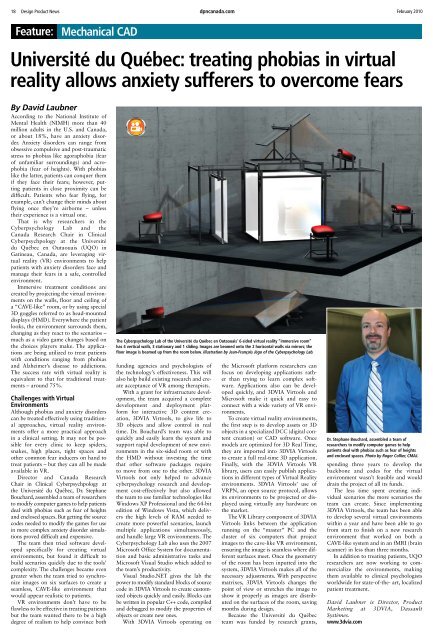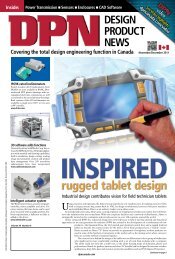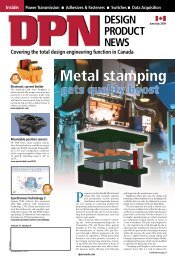Complete DPN February 2010 - Design Product News
Complete DPN February 2010 - Design Product News
Complete DPN February 2010 - Design Product News
You also want an ePaper? Increase the reach of your titles
YUMPU automatically turns print PDFs into web optimized ePapers that Google loves.
18 <strong>Design</strong> <strong>Product</strong> <strong>News</strong><br />
Feature: Mechanical cAD<br />
By David Laubner<br />
According to the National Institute of<br />
Mental Health (NIMH) more than 40<br />
million adults in the U.S. and Canada,<br />
or about 18%, have an anxiety disorder.<br />
Anxiety disorders can range from<br />
obsessive compulsive and post-traumatic<br />
stress to phobias like agoraphobia (fear<br />
of unfamiliar surroundings) and acrophobia<br />
(fear of heights). With phobias<br />
like the latter, patients can conquer them<br />
if they face their fears; however, putting<br />
patients in close proximity can be<br />
difficult. Patients who fear flying, for<br />
example, can’t change their minds about<br />
flying once they’re airborne – unless<br />
their experience is a virtual one.<br />
That is why researchers in the<br />
Cyberpsychology Lab and the<br />
Canada Research Chair in Clinical<br />
Cyberpsychpology at the Université<br />
du Québec en Outaouais (UQO) in<br />
Gatineau, Canada, are leveraging virtual<br />
reality (VR) environments to help<br />
patients with anxiety disorders face and<br />
manage their fears in a safe, controlled<br />
environment.<br />
Immersive treatment conditions are<br />
created by projecting the virtual environments<br />
on the walls, floor and ceiling of<br />
a “CAVE-like” room, or by using special<br />
3D goggles referred to as head-mounted<br />
displays (HMD). Everywhere the patient<br />
looks, the environment surrounds them,<br />
changing as they react to the scenarios –<br />
much as a video game changes based on<br />
the choices players make. The applications<br />
are being utilized to treat patients<br />
with conditions ranging from phobias<br />
and Alzheimer’s disease to addictions.<br />
The success rate with virtual reality is<br />
equivalent to that for traditional treatments<br />
– around 75%.<br />
challenges with Virtual<br />
environments<br />
Although phobias and anxiety disorders<br />
can be treated effectively using traditional<br />
approaches, virtual reality environments<br />
offer a more practical approach<br />
in a clinical setting. It may not be possible<br />
for every clinic to keep spiders,<br />
snakes, high places, tight spaces and<br />
other common fear inducers on hand to<br />
treat patients – but they can all be made<br />
available in VR.<br />
Director and Canada Research<br />
Chair in Clinical Cyberpsychpology at<br />
the Université du Québec, Dr. Stephane<br />
Bouchard, assembled a team of researchers<br />
to modify computer games to help patients<br />
deal with phobias such as fear of heights<br />
and enclosed spaces. But getting the source<br />
codes needed to modify the games for use<br />
in more complex anxiety disorder simulations<br />
proved difficult and expensive.<br />
The team then tried software developed<br />
specifically for creating virtual<br />
environments, but found it difficult to<br />
build scenarios quickly due to the tools’<br />
complexity. The challenges became even<br />
greater when the team tried to synchronize<br />
images on six surfaces to create a<br />
seamless, CAVE-like environment that<br />
would appear realistic to patients.<br />
VR environments don’t have to be<br />
flawless to be effective in treating patients<br />
but the team wanted there to be a high<br />
degree of realism to help convince both<br />
dpncanada.com <strong>February</strong> <strong>2010</strong><br />
université du Québec: treating phobias in virtual<br />
reality allows anxiety sufferers to overcome fears<br />
the cyberpsychology Lab of the université du Québec en outaouais’ 6-sided virtual reality “immersive room”<br />
has 4 vertical walls, 3 stationary and 1 sliding. images are beamed onto the 2 horizontal walls via mirrors; the<br />
floor image is beamed up from the room below. illustration by Jean-François Jégo of the cyberpsychology Lab.<br />
funding agencies and psychologists of<br />
the technology’s effectiveness. This will<br />
also help build existing research and create<br />
acceptance of VR among therapists.<br />
With a grant for infrastructure development,<br />
the team acquired a complete<br />
development and deployment platform<br />
for interactive 3D content creation,<br />
3DVIA Virtools, to give life to<br />
3D objects and allow control in real<br />
time. Dr. Bouchard’s team was able to<br />
quickly and easily learn the system and<br />
support rapid development of new environments<br />
in the six-sided room or with<br />
the HMD without investing the time<br />
that other software packages require<br />
to move from one to the other. 3DVIA<br />
Virtools not only helped to advance<br />
cyberpsychology research and development<br />
cost-effectively but also allowed<br />
the team to use familiar technologies like<br />
Windows XP Professional and the 64-bit<br />
edition of Windows Vista, which delivers<br />
the high levels of RAM needed to<br />
create more powerful scenarios, launch<br />
multiple applications simultaneously,<br />
and handle large VR environments. The<br />
Cyberpsychology Lab also uses the 2007<br />
Microsoft Office System for documentation<br />
and basic administrative tasks and<br />
Microsoft Visual Studio which added to<br />
the team’s productivity.<br />
Visual Studio.NET gives the lab the<br />
power to modify standard blocks of source<br />
code in 3DVIA Virtools to create customized<br />
objects quickly and easily. Blocks can<br />
be written in popular C++ code, compiled<br />
and debugged to modify the properties of<br />
objects or create new ones.<br />
With 3DVIA Virtools operating on<br />
the Microsoft platform researchers can<br />
focus on developing applications rather<br />
than trying to learn complex software.<br />
Applications also can be developed<br />
quickly, and 3DVIA Virtools and<br />
Microsoft make it quick and easy to<br />
connect with a wide variety of VR environments.<br />
To create virtual reality environments,<br />
the first step is to develop assets or 3D<br />
objects in a specialized DCC (digital content<br />
creation) or CAD software. Once<br />
models are optimized for 3D Real Time,<br />
they are imported into 3DVIA Virtools<br />
to create a full real-time 3D application.<br />
Finally, with the 3DVIA Virtools VR<br />
library, users can easily publish applications<br />
in different types of Virtual Reality<br />
environments. 3DVIA Virtools’ use of<br />
VRPN, an open source protocol, allows<br />
its environments to be projected or displayed<br />
using virtually any hardware on<br />
the market.<br />
The VR Library component of 3DVIA<br />
Virtools links between the application<br />
running on the “master” PC and the<br />
cluster of six computers that project<br />
images to the cave-like VR environment,<br />
ensuring the image is seamless where different<br />
surfaces meet. Once the geometry<br />
of the room has been inputted into the<br />
system, 3DVIA Virtools makes all of the<br />
necessary adjustments. With perspective<br />
matrixes, 3DVIA Virtools changes the<br />
point of view or stretches the image to<br />
show it properly as images are distributed<br />
on the surfaces of the room, saving<br />
months during design.<br />
Because the Université du Québec<br />
team was funded by research grants,<br />
Dr. stephane Bouchard, assembled a team of<br />
researchers to modify computer games to help<br />
patients deal with phobias such as fear of heights<br />
and enclosed spaces. Photo by roger collier, cMAJ.<br />
spending three years to develop the<br />
backbone and codes for the virtual<br />
environment wasn’t feasible and would<br />
drain the project of all its funds.<br />
The less time spent creating individual<br />
scenarios the more scenarios the<br />
team can create. Since implementing<br />
3DVIA Virtools, the team has been able<br />
to develop several virtual environments<br />
within a year and have been able to go<br />
from start to finish on a new research<br />
environment that worked on both a<br />
CAVE-like system and in an fMRI (brain<br />
scanner) in less than three months.<br />
In addition to treating patients, UQO<br />
researchers are now working to commercialize<br />
the environments, making<br />
them available to clinical psychologists<br />
worldwide for state-of-the- art, localized<br />
patient treatment.<br />
David Laubner is Director, <strong>Product</strong><br />
Marketing at 3DVIA, Dassault<br />
Systèmes.<br />
www.3dvia.com
















